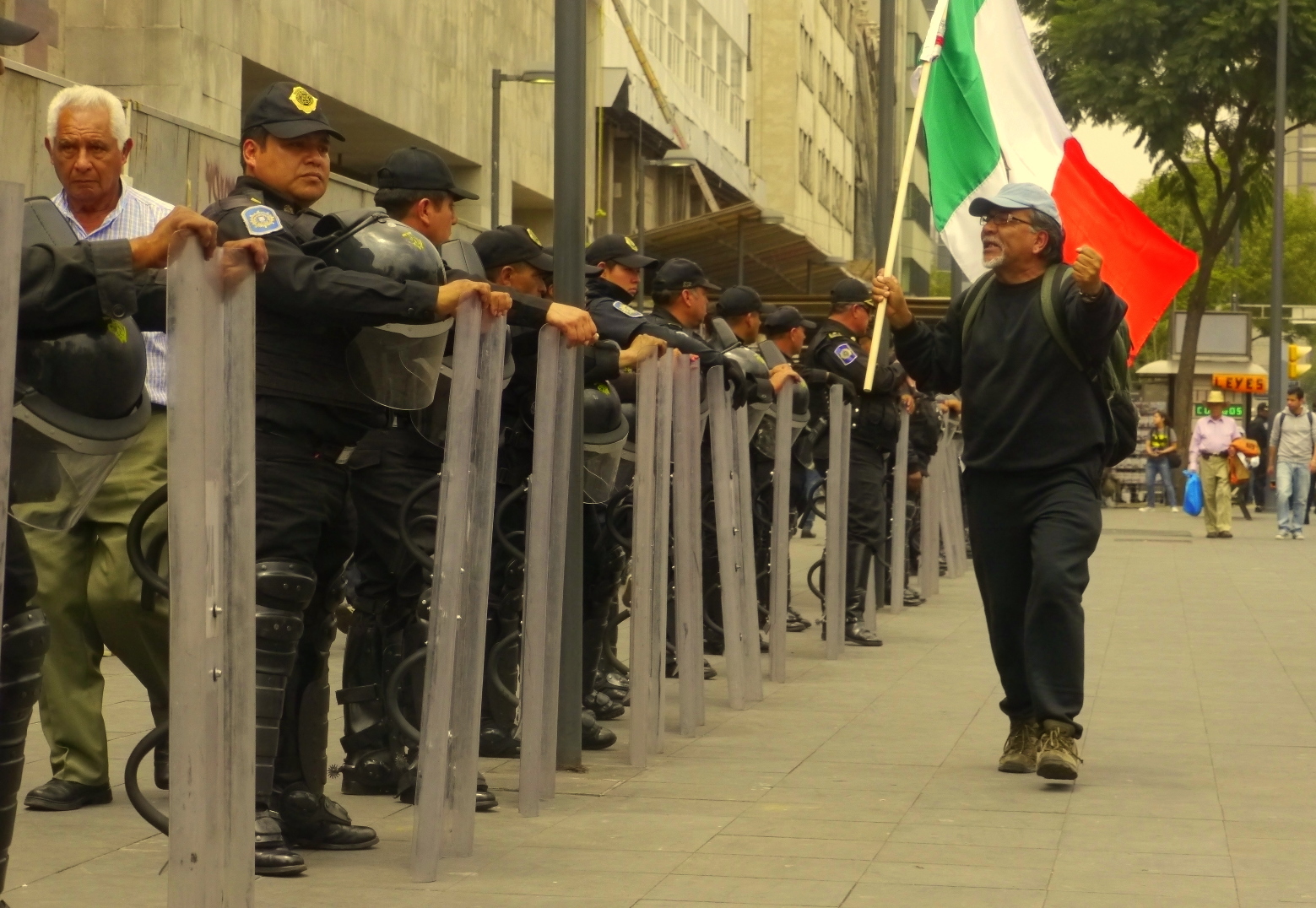I wrote the following based upon two trips to Mexico City, one in July-September 2013 and the other for two weeks in December 2013. I don’t claim to fully explain the current state of Mexican politics and social movements, but perhaps this can provide, for the “vecino distante” (distant neighbor) in the United States, an idea of what’s happening right next door, always of importance and unfortunately, usually ignored.
The papers on every news kiosk in Mexico City in late August 2013, blared denunciations: “Imagine — Mexico Without Soccer!” screamed one newspaper. Pictures of crying children stuck outside of a stadium clutching the colors of their favorite team were plastered on the front page of another paper.
The target of the media’s ire was the National Coordinator of Education Workers, or CNTE, Mexico’s nationwide teachers’ union, who had the previous day shut down a soccer match by surrounding the stadium. For weeks, crowds of teachers had been disrupting anything they could in Mexico’s capital, including the massive Benito Juarez International Airport.
The teachers were out in force to protest against President Enrique Pena Nieto’s (or EPN’s) proposed changes to the country’s education system, political system, and petroleum. Named the “Pacto Por Mexico” (Pact For Mexico), an eerie echo of the U.S. Republican Party’s 1990 “Contract With America”, these “reforms” were widely seen as blatant neoliberal attacks upon the Mexican body civic.
EPN’s plans for education were based on the government’s call to improve the admittedly-dismal state of the country’s education system. However, the proposed solution was a direct assault on the teachers’ union, with a major bone of contention being a proposed test that every teacher in Mexico would have to complete, and the union warned that those teachers who failed the test would lose their jobs. The government countered that this was fiction, and a bitter debate raged in different publications and websites, with the charmingly-named “Mexicanos Primero” or “Mexicans First” website providing a slick counterpoint to the unions’ arguments.
Perhaps the teachers who failed the test would indeed not be fired, at least not immediately, but it would provide the state with ammunition for future anti-labor shenanigans, so it’s no wonder they were opposed to the endeavor. Part of the problem in deciphering Mexican politics is that it is utter foolishness to believe anything at all that the Mexican government says, ever. In spite of multiple social movements that have shaken the country often to its core, and the ruling PRI party being knocked from its position of absolute power after 71 years, Mexico remains in the hands of an increasingly uber-wealthy kleptocratic ruling class. Lest we forget: until he was kicked to second place earlier this year by Warren Buffet, the richest man in the world was Carlos Slim, a Mexican, albeit one who lives in an armored villa in the exclusive Lomas de Chapultepec neighborhood. Even the Mexicanos Primero website itself is insidious: it is owned and operated by the same family that owns Televisa, one of Mexico’s two television stations, who some say are using their position to poise themselves to step into the job of running the country’s schools once the unions are broken and the doors are opened to privatization.
And so in August the CNTE gathered in Mexico City and set up a planton, or a protest camp in the Zocalo, and began staging daily marches. They were soon joined by the more militant Section 22 from Oaxaca, the same union that had been at the center of the massive protests in 2006 that rocked that city and its environs, as well as teachers from Michoacan, Veracruz and elsewhere. And within a few weeks the teacher’s marches had shut down two television stations, a government building called the Segob, and the aforementioned soccer match. Then they successfully closed the capital’s massive (and mind-numbingly labyrinthine) Benito Juarez International Airport by blocking all the roads that led to it. Twice. Then the CNTE called for a massive mobilization on September 3, 2013.
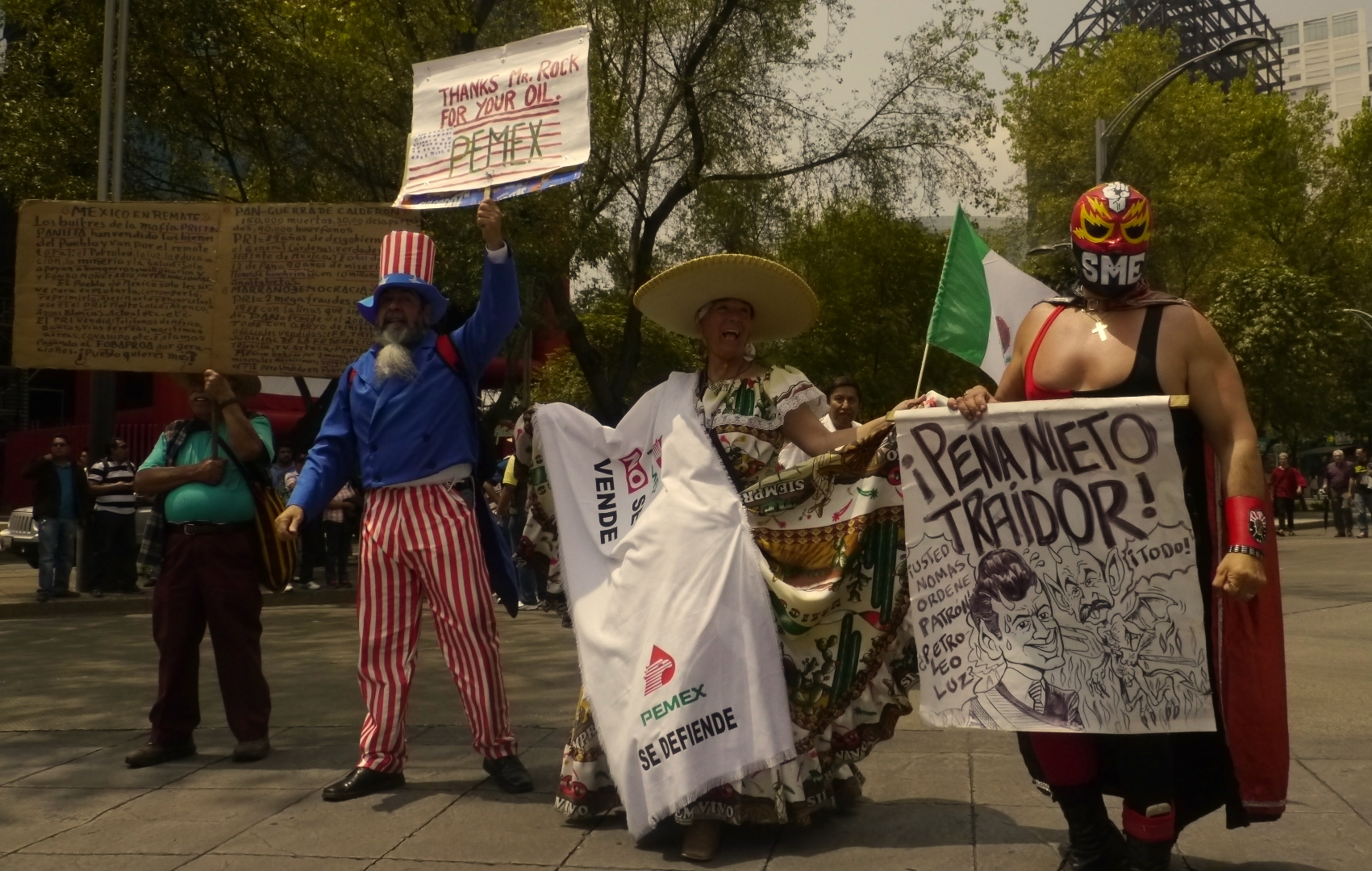
There were two mass marches, one down Insurgentes Avenue and the other from the Monument of the Revolution towards the Chamber of Deputies. Upwards of 100,000 people filled the streets in both locations. I followed the latter group, which was fronted by a blue phalanx of riot police walking backwards, then followed directly by a cluster of journalists, their cameras hoisted on a small forest of monopods, who would later unknowingly act as a buffer between protesters and police.
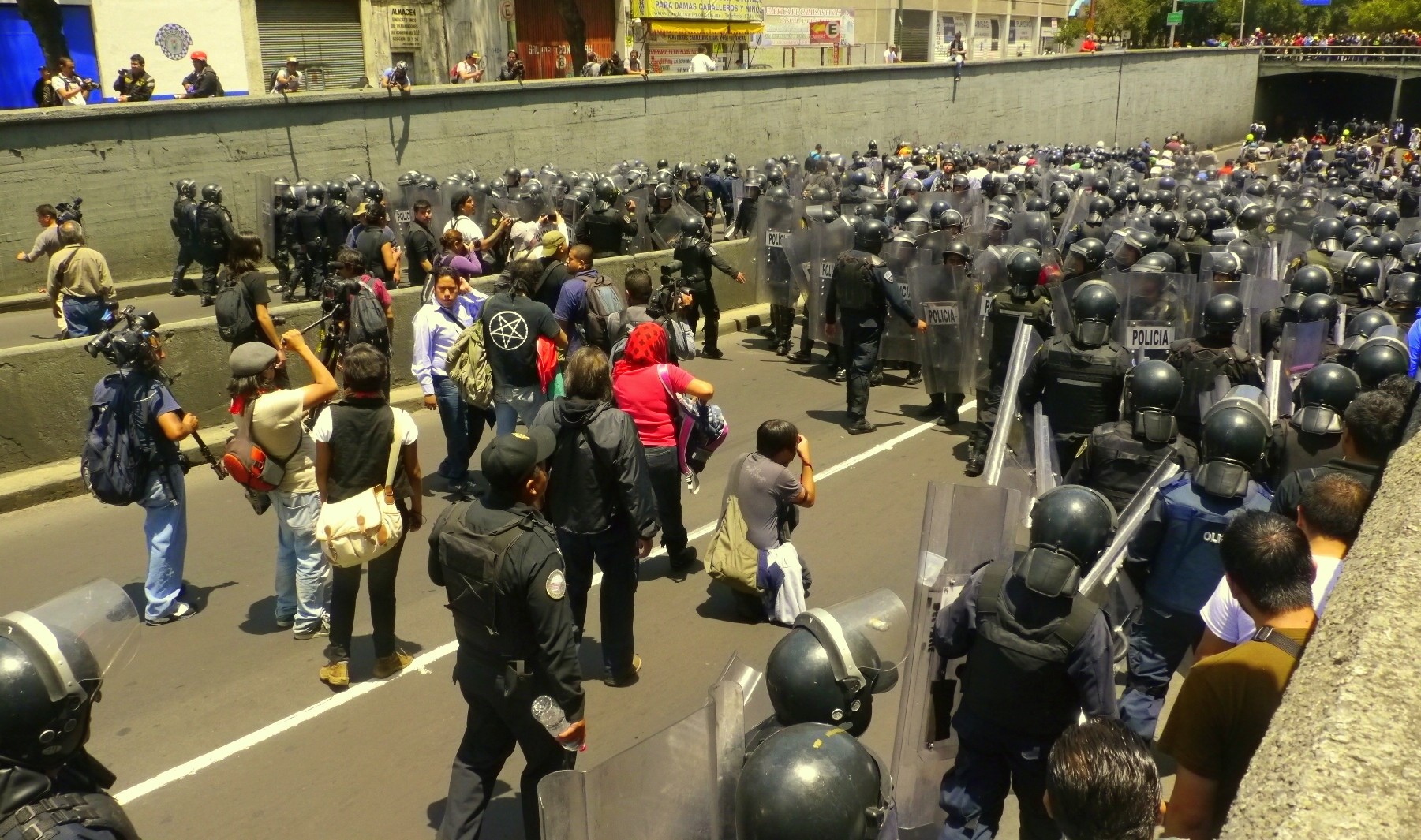
The march was also lined on both sides by police, who were using the “Berlin Kettle” form of demonstration control. The Mexico City cops looked to have called upon all of their reserves that day, as I saw youths of no more than 17 years old and señores of over 60 among their ranks, their lopsided riot helmets barely fitting their heads. The comical and the dangerous mixed together in Mexico City.
The march for the Chamber of Deputies left the Monument and walked past the Alameda and the museum of Bellas Artes, turning south on the Eje Central, all the while flanked by police with plastic riot shields, making a kind of flimsy wall between the march and the onlookers on the sidewalks.
As we passed one intersection a small group of masked protesters clad in faded black clothes and wielding sticks and metal pipes ran up from a side street.
Standing and pausing directly in front of the plastic police-shield wall as if for dramatic effect, they then straight out attacked the police line, throwing punches over the cops’ shields and pounding the surprised officers with metal poles. The police line broke, other militants joined the fray, and thus began a day-long running skirmish of multiple fights, arrests, attacks and counterattacks.
The main march moved on, leaving the militants to be pursued by squads of riot police, but the mood had intensified.
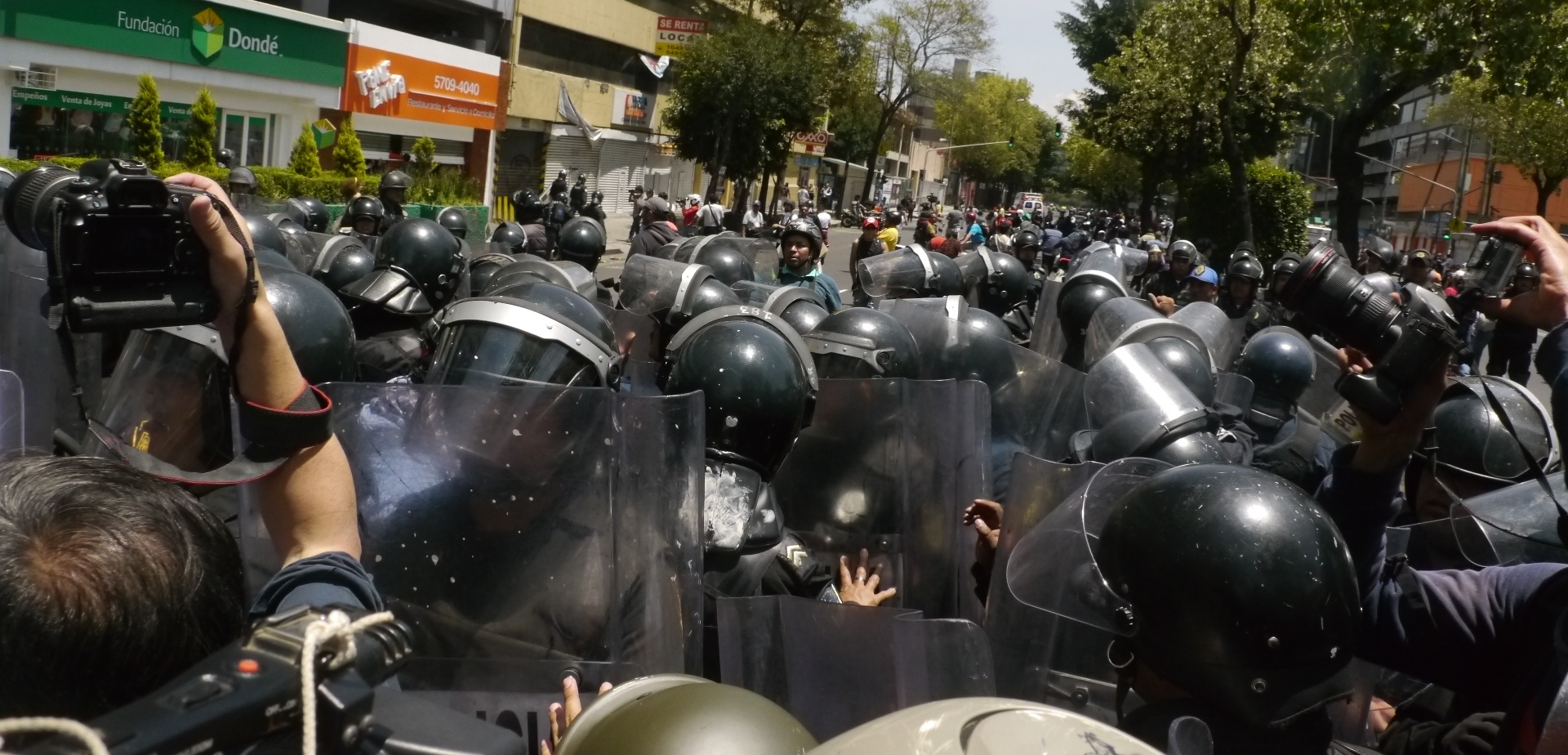
By late afternoon the marchers had stopped several blocks from the Chamber of Deputies, itself ringed by ten-foot-tall metal barricades. While the representatives of the teachers’ union debated and negotiated whether the march was to advance, and while everyone else chided and sweated in the heat, the police, still massed in front of us in five-deep lines of officers, sent a small radio-controlled “drone” helicopter to take pictures of the assembled crowd from above. When a group of protesters began taking potshots at it with powerful, five-foot long Mexican bottlerockets, the drone ‘copter buzzed quickly to safety behind the police lines while the demonstrators laughed and cheered.
The afternoon wore on, with union representatives intoning speeches over a PA system on the back of a pickup, and demonstrators patiently waiting under the beating sun to see if we would advance on the Chamber of Deputies or not.
Cocksure militants dashed off to buy gasoline and began making molotov cocktails in the middle of the street, in full view of the hundreds of police, and they were duly photographed by plainclothesmen on the nearby rooftops.
Suddenly there were a series of teargas grenades exploding and people began running down the narrow side streets, pursued by police. As they fell back someone made a flimsy barricade in the middle of the street and lit it on fire, and armored police vans rolled over it, chasing the crowd through an abandoned amusement park and past a large group of Aztec dancers who were practicing their routines, all of which added a surreal edge to the day.
After putting many blocks between themselves and the police that crowd of demonstrators headed towards the San Antonio Abad metro station, as clots of other tired demonstrators joined them, trudging along the sidewalk in the grimy Mexico City air. Then there were the sounds of scuffling behind them and the protesters broke into a run, with three armored police trucks bearing down upon them. They poured into the metro station, vaulting the turnstiles and pounding up the stairs to the platform. A train arrived and the marchers boarded, as police officers swarmed into the station and pulled the brakes on the train, then boarded it, truncheons swinging, mercilessly beating some people, dragging others away by their hair, and opening up with pepper-spray inside the subway car at anyone they deemed an appropriate target. People yelled and protested but they dragged their victims away as the train finally lurched out of the station, and it was only thanks to the heroic filming of the video-activistas of the Subversiones media group, who had one of their own clapped in irons and packed off to jail for his efforts, that the story of those brutal arrests even got out to the world at all, as the Mexican corporate news media were nowhere to be found.
The protests of that day reverberated through the news media, and more actions followed in the coming weeks. But with Independence Day, September 16, rapidly approaching the government desperately wanted the teachers’ planton out of the Zocalo. And so on September 13, thousands of riot police charged the encampment and evicted the teachers, many of whom fell back to the Monument Of The Revolution and promptly set up another camp, and called for another demonstration on October 2, the anniversary of the 1968 Tlatelolco massacre.
That march was hotly anticipated, coming as it did on the heels of the past months’ organizing and demonstrations. In response the marchers were met with thousands of riot police, resulting in a day long series of conflicts that ended in 107 arrests and the downtown streets once again rolling in tear gas.
As December loomed, and the government prepared to enter the Chamber of Deputies to debate the “Political Reform” and the “Energy Reform” sections of the Pacto Por Mexico, the latter dealing specifically with privatization of the country’s oil, organizers called for another mobilization on December 2.
In the meantime, Andres Manuel Lopez Obredor or AMLO, former mayor of the capital and 2006 PRD presidential candidate (who had his victory snatched away from him by PRI computer shenanigans in that year) had used his political clout to form a new group, called the Movimiento Por La Regeneracion Nacional (Movement of National Regeneration) or Morena. As the CNTE organized its demonstrations and debated its tactics, AMLO now called on the Morenistas to rally at the Zocalo on December 2 — but at the exact same time as the CNTE had called for their own demonstrations. Once again, the PRD seemed to be fulfilling its role as the “loyal opposition” and acting as a buffer between social movements and the state.
Meanwhile, in a clear attempt to intimidate the protesters, the government declared publicly that there would be undercover police infiltrating the marches, sending chills down people’s spines as they speculated about agents provocateurs and “snatch squads”. The stage looked set for a repeat of the violent clashes of December 2012, exactly one year before, when protests against EPN’s inauguration to the presidency turned into bloody police beatings and mass arrests.
Still, as we gathered that morning at the Monumento Para La Revolucion, the question remained: what could the teachers do? Occupying pubic spaces, massive marches, shutting down Mexico City’s airport multiple times – these tactics that in other countries would send tremors through society, in Mexico all of these had been tried already in recent months and years, and yet still the state plowed onward with its plans. The Mexican body politic had clearly stated its opposition to what was going on, and yet it continued.
The morning of December 2, thousands of people gathered at the Monument To The Revolution, and we began trooping along Reforma towards downtown, with clots of black-clad plainclothes police on the sidewalks on either side following us. Was the march heading to the Zocalo, where the Morena movement would be holding a speech-fest, or elsewhere? No one had come up with a plan it seemed, and we marched past the Alameda and eventually, indeed, to the Zocalo, where we were greeted by a massive MORENA banner above a stage as PRD politicians thundered through the PA system their determination to combat EPN’s reforms. Our march of teachers, unionists, and anarchists melted into the much larger crowd, and at that moment the energy was lost. We had barely arrived when the Morena rally ended, and the last CNTE protest of 2013 ended with a whimper and not a bang. A small group of militants later broke off to go and pelt the studios of Televisa with rocks and there followed a few arrests, but overall the mood was one of dejectedness. The question remained: what is to be done?

Now the focus turned to the Senate vote on the nation’s oil. But in the meantime, a new armed guerrilla group announced its presence in the country.
Meanwhile, In The Hinterland
All of this was happening in Mexico City, the nation’s capital, and Mexico is an extremely centralized country. However in the “background” as it were, in the states of Guerrero and Michoacan, after enduring years of horrific violence at the hands of the various drug cartels, the campesinos had, as they say, taken the law into their own hands.
The first of these “community police” organizations, La Policía Comunitaria of Guerrero, was begun in 1995. When they held their 15th anniversary (which I reported on here) in 2010, they were the only organization of their kind in the country. As of this writing, there are now autodefensa or self defense groups in at least ten states in Mexico, by some counts. And some, like the people’s defense group in Cherán, Michoacan, have also arisen to defend their region’s forests from illegal logging, an additional area of business the drug cartels have recently entered into.
And on December 3, two days after the CNTE marched to the Zocalo, a new guerrilla group emerged in Guerrero, the Armed Revolutionary Liberation Forces of the People, or FAR-LP. Mexicans had been expecting something like this for awhile, especially as Guerrero, along with Michoacan, are the states in the country where arguably the most dynamic social movements are occurring – as locals battle narcos over control of the land and public safety.
The FAR-LP probably contains members of the recently-disbanded Popular Revolutionary Army, or EPR, which had started in Guerrero and later split into smaller factions.
The point here is that in the background to all of the actions in the capital, Mexico is a country that has endured years of unbridled carnage from the narco-wars, and the population has responded in kind with grassroots movements of self-defense. This adds a whole other layer to contemporary Mexican politics, and one that is unpredictable – a pair of wild cards for the future of the country.
Morenistas En Frente Del Senado
Back in Mexico City the attention now turned to the Senate vote on privatizing the nation’s petroleum. Mexico’s nationalized oil goes back to 1936, when Mexican president Lazaro Cardenas played a shrewd game of political brinksmanship and bet that Franklin D. Roosevelt would be too preoccupied with the looming world war to land the Marines at Veracruz (as Woodrow Wilson had in 1914) were Cardenas to pull a political maneuver that was unsavory to los gringos, and he proved correct.
Cardenas nationalized the country’s petroleum, threw out the yanqui oil corporations, and the oil became a source of national pride, with Mexicans well aware that they lived just south of a nation that is infamous for invading countries on behalf of its gas companies. Now eighty-odd years later, EPN’s government claimed that “cooperation” was needed between Pemex, the national Mexican oil company, and foreign corporations. This was clearly coded language for privatization, and everyone knew it. The Senate was set to debate the issue, and the Morenistas set up large video screens in front of the Senate building to broadcast the debates inside, with the building itself ringed by twelve-foot high metal barricades. Those metal walls in turn were plastered with posters, stickers and graffiti decrying the selling off of the nation’s petroleum reserves. “Traidores!” – “Traitors!” barked some, others going further “Putos Por Exxon!” – “Whores For Exxon!”.
Morena supporters were out in force in front of the Senado hammering on the metal walls with fists, feet, and sticks, attempting to drown out the discussions inside with their cacophony.
A man with a short Mohawk haircut made repeated flying kicks at the metal walls while the lines of protesters beating on them clamored on as the sun fell. All along the blocks on Reforma that housed the Mexican Senate the Morenistas had pitched their tents and watched the debate on the portable video screens.
One by one the different politicians mounted the podium with the crowd either cheering or jeering depending upon who was addressing the Senado. Fair-skinned PANistas somberly declared the need for “progress” and re-affirmed their deep concern for their homeland’s future, while the PRIistas said pretty much the same thing, and the PRD denounced them all, but itself lacked the seats to stop them.
The mood was angry that day, but later seemed to turn more festive, maybe because it was also the first day of posada, a traditional December through January series of parties, or perhaps because this important decision happened to coincide with the annual “Coca Cola Parade” down the Eje Central, when people dress in red and white to show their appreciation for the corporation that destroys children’s teeth across the country.
But at the end of the day, the vote went through, and Mexico’s petroleum was officially un-nationalized. A historic move against the people had just happened, and no one seemed to know what to do next. The Morenistas packed up their tents and video screens and went home, and the capital began to close up for the holidays. As we rolled into 2014, the remaining teachers’ encampments at Revolution Monument were evicted by police on January 6, putting an end to this particular chapter in that movement’s history.
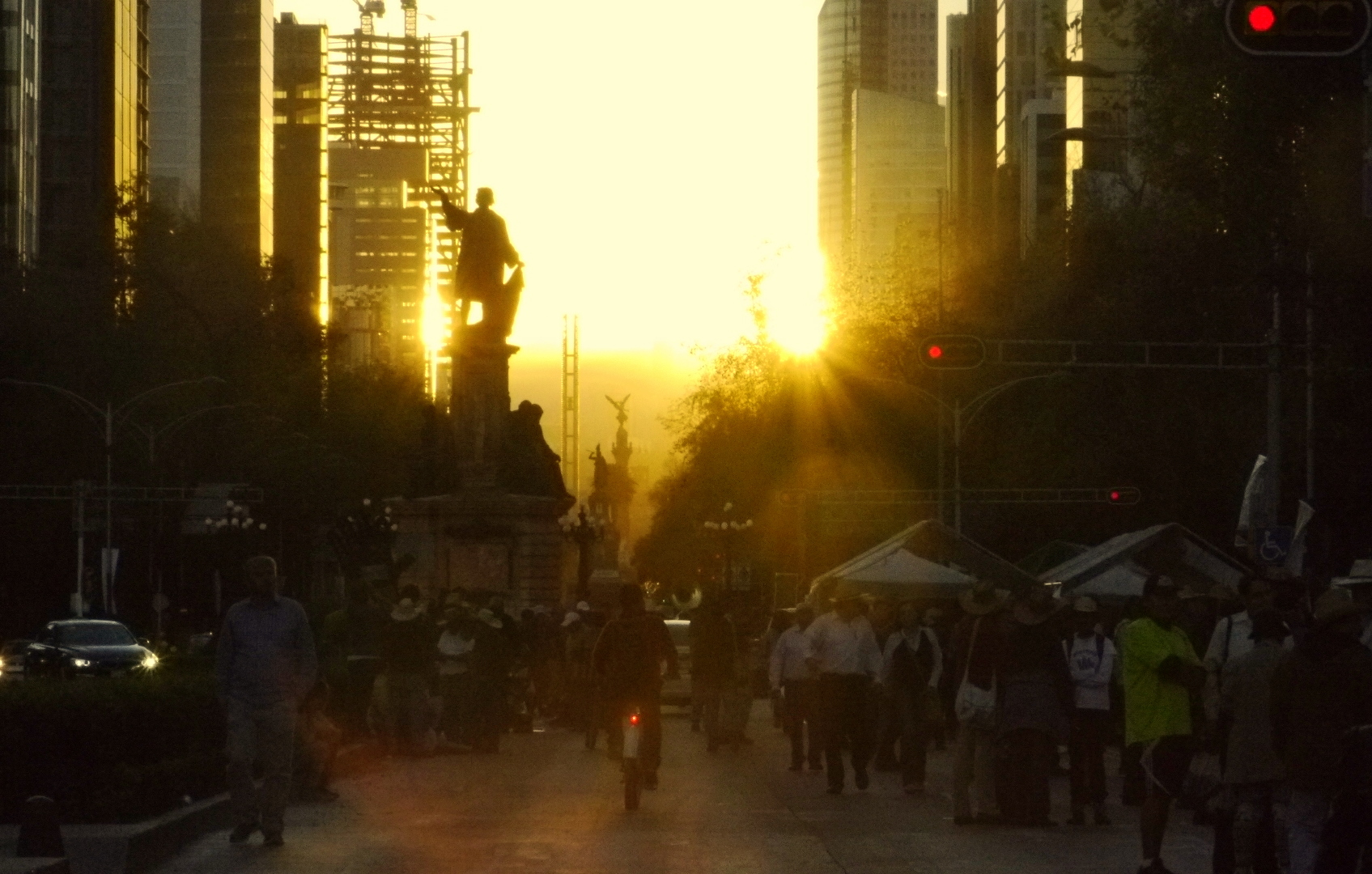
So what does this mean? The teachers union being beat down means that, if the government follows through with its plans and privatizes the school system, thousands if not millions of unemployed people may be dumped onto the economy of an already poor country. Meanwhile the petroleum being sold off will most likely raise the price of gasoline and therefore the cost of living in the country will go up, perhaps dramatically. One need look no further than the example of the Mexican telephone system, Telmex, which was privatized by the government and then promptly purchased by the aforementioned billionaire Carlos Slim, and now Mexicans pay the highest rates for their cellphones on the entire planet.
It’s pointless to call Mexico a “powder keg”, as countless regions in the world can be accurately said to match that description at any given time. One difference with Mexico is that every once in a while, Mexico actually explodes. Indeed that is precisely what many think was the actual reason behind the current “Drug War” in Mexico: President Calderon wanted to freeze the social movements that seemed to be sweeping the country, from the millions who took to the streets to support AMLO when the election was stolen from him in 2006, to the militant teachers of Oaxaca who virtually took over that city’s center for several months that same year. The image of Mexico that was projected all over the world was of a people with its fists in the air, and just a few years later that image had changed to one of decapitated drug soldiers propped along a highway in the middle of the desert.
But now, through its self-defense groups, unions, and other social movements, Mexico appears to be coming back to the forefront of struggle, or one can only hope. Here’s to a new year of social movements, all over the world.
All photos by David Martinez

